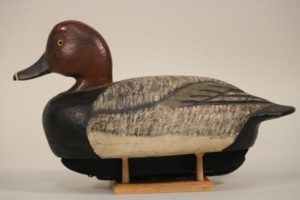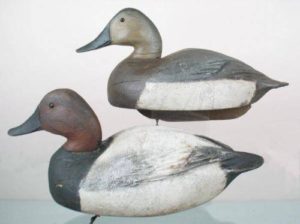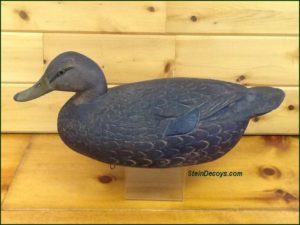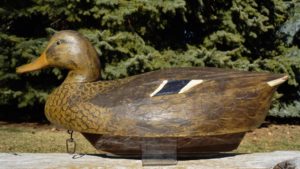A Michigan Premier Decoy Carver
A Decoy Corner Article
By Bruce Urben, President
While most of my Decoy Corner articles have focused on Wisconsin’s original carvers, one carver in neighboring Michigan was very well known, and some described his product as “the All American Working Decoy”.
Benjamin S. Schmidt was born in 1884 and was by far the best known Michigan carver. He lived in Centerline, a community at the northern edge of Detroit his entire life and was known to hunt the St. Claire Flats area in Michigan.
Schmidt made his first decoys in 1914 when he needed decoys for hunting. His life-like style is not typical for Michigan carvers. Ben used old cedar telephone poles, cut to length and split in half for his decoy bodies. He had to borrow a bandsaw from a neighbor to rough out his bodies and used hand tools; a hand axe, lathers hatchet, spokeshave, plane and rasps to finish them. All of his hollow decoys were drilled out from the bottom and had a bottom board attached. He almost always relief carved the wing tips and tail feathers. A distinctive feature of Schmidt’s carving was his feathering, which he “stamped in” with a special tool he made. The tool resembled a small, squeezed end pipe, sharpened at one end. He placed the tool against the decoy back and tapped it with a hammer to make the feather indentation. Different sized pipe tools made feather indentations of different sizes.
Schmidt’s need for hunting decoys turned the production into a commercial volume in the 1940’s – ’50’s. He sold decoys in the hundreds to local sporting goods stores; one of his primary outlets was the J. L. Hudson Department Store in Detroit. While in his production phase, and while running behind on completing orders, he used his older brother Frank to help him carve and paint. Although Frank was a good carver, Ben’s technique and painting seemed to be far superior to Frank’s work.
Ben carved all species of ducks and geese hunted in the Midwest. Later in life, he carved decorative and miniatures. He painted in oils and his paint style was simple, but he used wet on wet technique with lifelike shading and blending.
According to Warman’s Duck Decoys (Russell Lewis’s, 2006), most collectors figure that a Ben Schmidt decoy of any quality is worth $1,000. His goose decoys are valued at numbers double that of his ducks. I have seen Ben Schmidt decoys selling at decoy auctions for $250-$5,000 for some rarer species in excellent condition.
Ben continued carving decorative and miniatures until his death in 1968 at the age of 93. Many of Ben’s decoys are signed or stamped, but those sold to large department stores or sports shops may have their label only.
You should consult a reputable dealer or collector for verification of a Ben Schmidt decoy before purchasing, as many Michigan carvers tried to copy his style and technique.




